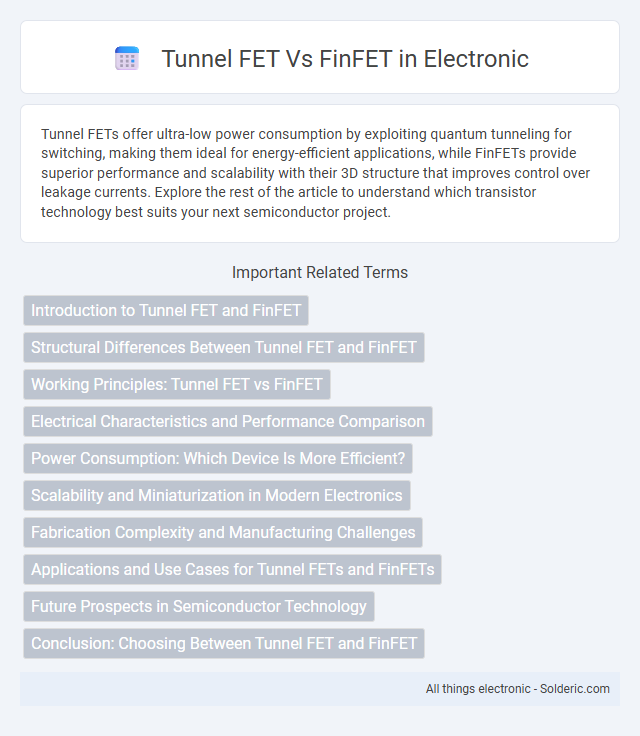Tunnel FETs offer ultra-low power consumption by exploiting quantum tunneling for switching, making them ideal for energy-efficient applications, while FinFETs provide superior performance and scalability with their 3D structure that improves control over leakage currents. Explore the rest of the article to understand which transistor technology best suits your next semiconductor project.
Comparison Table
| Feature | Tunnel FET (TFET) | FinFET |
|---|---|---|
| Operating Principle | Quantum tunneling of carriers | Multi-gate field-effect transistor |
| Subthreshold Slope | Below 60 mV/decade (steeper) | ~60 mV/decade |
| Power Consumption | Ultra-low leakage, low power | Low leakage, moderate power |
| Drive Current | Lower drive current | Higher drive current |
| Technology Maturity | Emerging, experimental | Mature, commercialized |
| Application | Ultra-low power devices, sensors | High performance processors, SoCs |
| Manufacturing Complexity | Higher due to novel materials | Established CMOS processes |
| Scaling Potential | Good for sub-5nm nodes | Effective down to 3nm nodes |
Introduction to Tunnel FET and FinFET
Tunnel FETs (Field-Effect Transistors) utilize quantum tunneling to achieve low-voltage switching, offering significant power efficiency compared to traditional devices. FinFETs, characterized by their 3D fin-like gate structure, provide enhanced control over short-channel effects, improving performance and scalability in advanced semiconductor nodes. Your choice between Tunnel FET and FinFET impacts power consumption and device scaling in modern integrated circuit design.
Structural Differences Between Tunnel FET and FinFET
Tunnel FETs (TFETs) feature a gate-controlled p-n junction enabling band-to-band tunneling as the primary conduction mechanism, characterized by a narrower channel and steep subthreshold slope. FinFETs exhibit a 3D fin-shaped silicon channel wrapped by the gate on three sides, enhancing electrostatic control and reducing short-channel effects. Unlike FinFETs, TFETs rely on engineered heterojunctions or doping profiles to modulate tunneling current, emphasizing structural asymmetry critical for low-power operation.
Working Principles: Tunnel FET vs FinFET
Tunnel FET operates by leveraging quantum tunneling, allowing electrons to pass through an energy barrier rather than over it, resulting in lower power consumption and steeper subthreshold slope. FinFET, on the other hand, uses a three-dimensional multi-gate structure to control the channel more effectively, reducing short-channel effects and improving drive current. Your choice between Tunnel FET and FinFET depends on the trade-off between ultra-low power operation and high performance in semiconductor devices.
Electrical Characteristics and Performance Comparison
Tunnel FETs exhibit steep subthreshold slopes below 60 mV/dec, enabling ultra-low power consumption and reduced off-state leakage currents compared to FinFETs, which typically show subthreshold slopes around 60-90 mV/dec. FinFETs demonstrate higher drive current and ON-state performance due to enhanced electrostatic control via the 3D fin structure, making them well-suited for high-speed applications. While Tunnel FETs excel in low-voltage operation and energy efficiency, FinFETs maintain superior overall performance with improved short-channel effects and scalability in advanced CMOS technologies.
Power Consumption: Which Device Is More Efficient?
Tunnel FETs (TFETs) offer significantly lower power consumption compared to FinFETs due to their steep subthreshold slope, enabling operation at lower supply voltages and reduced leakage currents. FinFETs provide improved performance and control over short-channel effects, but their static power dissipation remains higher than TFETs, especially in ultra-low-power applications. Your choice depends on prioritizing ultra-low power efficiency, where TFETs outshine FinFETs, while FinFETs excel in high-performance scenarios.
Scalability and Miniaturization in Modern Electronics
Tunnel FETs offer superior scalability compared to FinFETs due to their ability to operate efficiently at sub-10nm channel lengths, enabling further miniaturization in modern electronics. FinFETs, while highly effective at current technology nodes around 14nm to 5nm, face increased short-channel effects and power leakage challenges as dimensions shrink beyond these limits. Tunnel FETs leverage band-to-band tunneling mechanisms that reduce power consumption and enhance switching behavior, making them promising candidates for ultra-scaled, low-power applications in next-generation semiconductor devices.
Fabrication Complexity and Manufacturing Challenges
Tunnel FETs exhibit lower fabrication complexity due to their planar structure and simpler doping requirements compared to the 3D fin-based architecture of FinFETs, which demands advanced lithography and precise fin patterning. Manufacturing challenges for Tunnel FETs include controlling the ultra-thin tunneling barrier and ensuring consistent interface quality, while FinFETs face difficulties in achieving uniform fin dimensions and precise gate alignment across large wafers. Your manufacturing choices should weigh the simpler process flow of Tunnel FETs against the scalability and established ecosystem of FinFET technology.
Applications and Use Cases for Tunnel FETs and FinFETs
Tunnel FETs (TFETs) excel in ultra-low power applications such as wearable devices, IoT sensors, and medical implants due to their steep subthreshold slope and minimal leakage current. FinFETs are widely adopted in high-performance computing, mobile processors, and advanced AI accelerators, offering superior drive current and scalability at advanced technology nodes like 5nm and 3nm. While TFETs enable energy-efficient always-on functionality, FinFETs dominate scenarios requiring high speed and robust thermal management.
Future Prospects in Semiconductor Technology
Tunnel FETs offer ultra-low power consumption and steep subthreshold slopes, making them promising candidates for future energy-efficient semiconductor technologies beyond the 5nm node. FinFETs, currently dominant in advanced nodes like 7nm and 5nm, provide high drive current and better electrostatic control but face scalability challenges below 3nm. Emerging research focuses on integrating Tunnel FETs with existing FinFET architectures to achieve both power efficiency and performance in next-generation semiconductor devices.
Conclusion: Choosing Between Tunnel FET and FinFET
Tunnel FETs offer superior subthreshold slope and lower leakage currents, making them ideal for ultra-low power applications and future nanoscale transistors. FinFETs provide better drive current, scalability, and thermal stability, which suit high-performance computing and current manufacturing technologies. Selection depends on specific use cases, balancing power efficiency with performance demands in semiconductor design.
Tunnel FET vs FinFET Infographic

 solderic.com
solderic.com